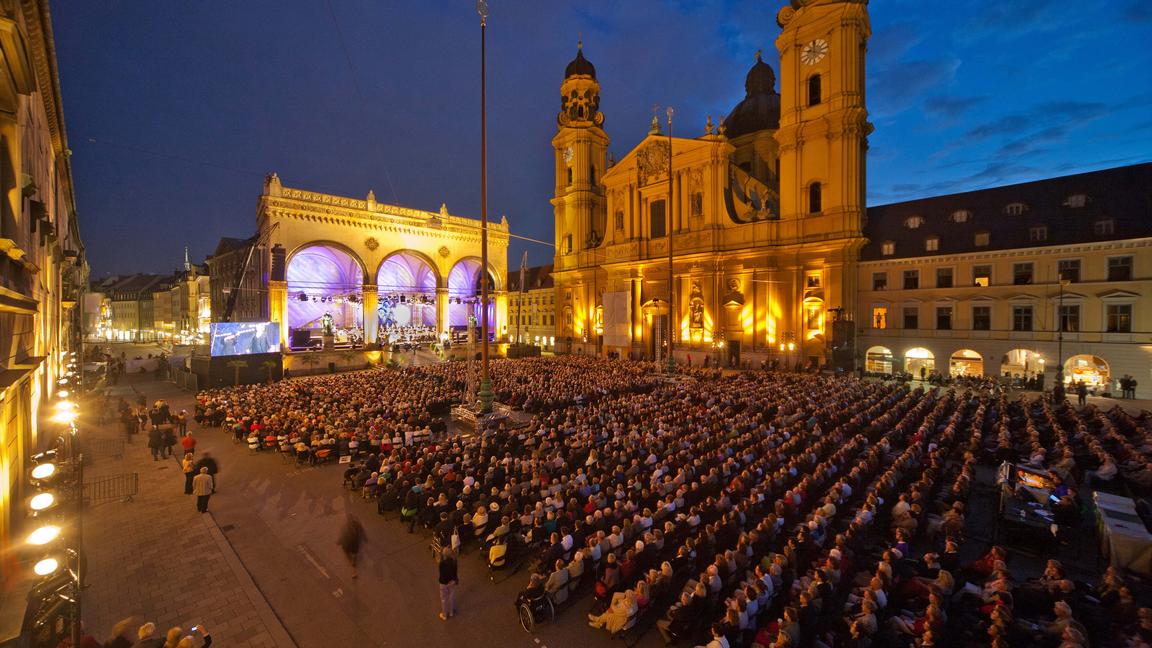"Klassik am Odeonsplatz", Munich
| Commissioned by: | Pro Events Veranstaltungs GmbH |
| Client: | City of Munich (Landeshauptstadt München) |
| Date: | since 2000, on the 1st weekend in July |
| Location: | Odeonsplatz, Munich |
| Services: | Audio, Sound Design, Lighting, Staging, static calculation |
| Project Manager: | Rudolf Pirc, Jan Deventer |
| Branch Office: | Munich |
| Special Features: |
|
"Klassik am Odeonsplatz" has been a highlight of Munich's summer of culture since its premiere in the year 2000. Framed by beautifully illuminated buildings and historical structures such as the Theaterine Church and the Residence Palace, every year the open air's unique atmosphere thrills an audience of 16,000 on a weekend in July. The Feldherrnhalle serves as the orchestra podium for the Bavarian Radio Symphony Orchestra and the Munich Philharmonic under the direction of renowned principal and guest conductors as well as for world-famous, top-class solo artists. Together they turn the Odeonsplatz into a unique classical experience held in high regard by international audiences.
Since the concerts began, we have been in charge of sound design, the P.A. system, television and creative lighting, as well as staging and temporary constructions. We work in close cooperation with the Bayerischer Rundfunk to ensure discerning classical and event audiences enjoy an audio and visual feast in a feel-good atmosphere. Over the years, we have constantly pushed the boundaries of the technically feasible and enhanced all aspects of the event – which is only possible if all those involved in the collaboration know they can depend on one another.
By providing a balanced sound for the entire Odeonsplatz – covering a length of 160 meters – we make sure that every member of the audience enjoys perfect sound wherever they may be sitting. One way we do this is by using "object-related sound", whereby – regardless of how far away they are from the loudspeakers – members of the audience perceive the sound exactly as it is produced by the instrument. The audience always locates the source of the sound to the same place. We arrange 64 objects in three segments in an acoustic space on the stage. These are then distributed to 24 groups of loudspeaker, which in turn are also divided into three: the nearfill in front of the stage; the midfill, which is produced for the space in the next 40 metres by a small line array at a height of seven metres in the roof of the stage; and the mainfill, which is provided by a large line array hanging 18 metres high and comprising 14 elements on each side. This set-up provides sound right through to the back row of the audience and is usually supported by two delay lines. The result is that individual loudspeakers can no longer be heard. Even those in the back row benefit from the fascinating impression of hearing the orchestra and solo artists quite naturally from the podium of the Feldherrnhalle.
With the aid of a room acoustics and 3D audio system, we also simulate a realistic concert hall, frequently praised by the media as providing the best sound for open-air events. The greatest challenge with this form of concert sound arises from the surrounding buildings, many of which are listed buildings. Their facades, and especially the gaps between them, create variations in sound delay and reverberation times. With the aid of up to 120 precision microphones, a sophisticated 3D audio matrix and 32 room simulators positioned around the audience, we generate "impulse responses" – that is to say additional sound reflection – and a spatial reverberation to match the atmosphere. This system is also used for monitoring for the artists themselves on stage. A further 30 loudspeakers ensure tangible direct sound as well as the feeling audiences are used to from being in a concert hall.
"Klassik am Odeonsplatz" had to wait until July 2021 to celebrate its 20th anniversary as the concert weekend had been cancelled the year before due to the pandemic. In line with the event's hygiene concept, only 8,000 classical music fans – half the usual number – were able to enjoy the four concerts, each of which concluded with standing ovations. In addition to the comprehensive, elaborate audio solutions, we were also responsible for the signal connections of all Bayerischer Rundfunk outside broadcast units and – for the first time in 2021 – for those of the ZDF and other broadcasters. Both concert evenings were streamed as video in BR-Klassik Concert and one of them with a delay on the ZDF. They were also broadcast on the radio and social media channels.
Photos: Ralph Larmann
























